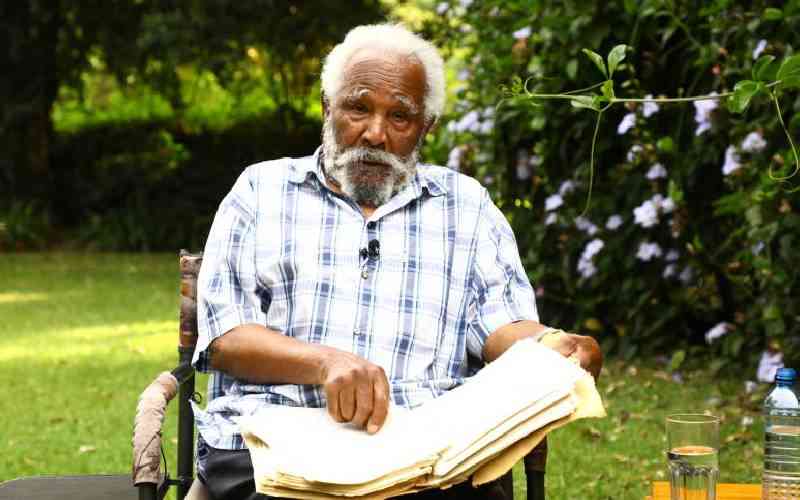By Njonjo Kihuria
Kenya: When the colonial administrators left Kenya in 1963, they destroyed most of the evidence of torture by setting ablaze incriminating materials in detention camps, prisons and emergency villages.
However remainders of that horrendous period when Kenyans were treated like slaves in their own country abound in forms of mass graves and remnants of the detestable dungeons among others.
Unfortunately, 50 years since independence, the government has not seen it fit to assist the Mau Mau veterans in preserving these sites.
Examples of the neglected sites include the deep, dark pits where the prison authorities buried Africans en masse in Narok town at the site where Jela Ndogo (mini prison) stood during the emergency. Others are the remnants of structures at Entara detention camp not too far away from Narok town. The mass graves were at times used to bury ‘offending’ Africans alive.
The Narok branch of the Mau Mau War Veterans Association has for several years now tried to have these sites preserved in honour of the struggle for independence. However due to lack of cooperation from authorities and to some extent incessant internal wrangles, no progress has been made.
“We have identified the sites where people were unlawfully detained, tortured and killed and buried in mass graves. However, our efforts to have them gazetted as national monuments have not borne fruits,” branch association secretary Charles Ngare said in a recent interview. The veterans want Jela Ndogo and structures within it preserved in memory of those who were tortured, killed and buried during the struggle for freedom.
Some of the deep pits with concrete bases where detainees used to be dropped to their death and others where many were buried after being killed by prison authorities still exist but are now overgrown with bushes. The Mau Mau officials claim that a church has been built on two such sites.
Ferry stolen guns
Torture and deaths witnessed at Jela Ndogo, also took place at the Entara detention camp, some 11 kilometers away from Narok town along the Mara River and although the colonial administration destroyed most of the evidence of torture, there are traces of its existence. However, most of the evidence has been destroyed by intensive farming going on along the river.
Just a few years ago, there were signs of similar pits as those at the Jela Ndogo, remnants of the camp’s perimeter fence and other ruins including pit latrine slabs and disused vehicle inspection pits.
Joseph Sironka ole Ketikai, one of the survivors of Jela Ndogo and Entara, recalled how as a ‘piki piki’ (gun runner for the Mau Mau) in the early 1950s, he used to ferry stolen guns and clothes from Narok to Mau Mau hideouts in Elementaita and Nyandarua.
According to him, Jela Ndogo was a police line that was also used as a prison for petty offenders prior to the declaration of the emergency in 1952. It became a detention site in 1952, mostly because it was difficult for prisoners to break out of it. “On the only side where prisoners could attempt escape, there was a deep, rugged depression. The Johnnies (young British soldiers) would watch from higher ground for possible break out attempts and then shoot the would-be escapees in cold blood,” he said.
Brutal interrogation
Ketikai claimed that directly under the pulpit of the church that stands on the former Jela Ndogo grounds, is the ten-foot deep hole where those murdered by the British and their collaborators were dumped.
Stay informed. Subscribe to our newsletter
Screening through brutal interrogation was done at another part of the present church compound. “The Johnnies used such torture methods as exposing their victims’ private parts to safari ants and inserting stinging leaves into women’s private parts,” he said.
The Mau Mau survivor explained that those who refused to confess to the Mau Mau oath were forced to dig two huge pits, which upon completion became their mass graves. “Men were buried alive heads down in one of the holes and the women in the other,” he said.
And where some semi permanent buildings now stand near the church, was the deep hole that was used to bury children, who mostly died of treatable diseases and neglect. Later to divert attention from the pits of death, the plot on the other side of the church, was turned into a cemetery.
At the ‘cemetery,’ people were buried in shallow graves and their bodies would be dug out and eaten by hyenas as Johnnies watched and hilariously took pictures.
People in the prison mostly died of typhoid, pneumonia and malaria, with children and pregnant women being affected most.
The British police were deliberately perpetuating the terribly unhygienic conditions and actually told the detainees that they could bring in doctors to treat them only if they confessed to having taken the Mau Mau oath and repented.
As more prisoners were brought in, the prison became congested and some detainees were relocated to Entara, a camp in the wild surrounded by wild animals including poisonous snakes.
“The idea was to take the prisoners to a place where they could not escape since they would be devoured by the wild animals if they attempted to run away. In fact in the initial stages, the invisible wild animals provided the security of a perimeter fence,” said Ketikai.
At Entara, a short white soldier nicknamed ‘Karukuma’ supervised the screening and the digging of two pits for burying those killed by the authorities or by disease.
The detainees were forced to walk long distances under guard to fetch building materials including thatching grass and poles. A few years ago, stumps of the poles that fenced the camp were still visible at the site.
 The Standard Group Plc is a
multi-media organization with investments in media platforms spanning newspaper
print operations, television, radio broadcasting, digital and online services. The
Standard Group is recognized as a leading multi-media house in Kenya with a key
influence in matters of national and international interest.
The Standard Group Plc is a
multi-media organization with investments in media platforms spanning newspaper
print operations, television, radio broadcasting, digital and online services. The
Standard Group is recognized as a leading multi-media house in Kenya with a key
influence in matters of national and international interest.
 The Standard Group Plc is a
multi-media organization with investments in media platforms spanning newspaper
print operations, television, radio broadcasting, digital and online services. The
Standard Group is recognized as a leading multi-media house in Kenya with a key
influence in matters of national and international interest.
The Standard Group Plc is a
multi-media organization with investments in media platforms spanning newspaper
print operations, television, radio broadcasting, digital and online services. The
Standard Group is recognized as a leading multi-media house in Kenya with a key
influence in matters of national and international interest.







